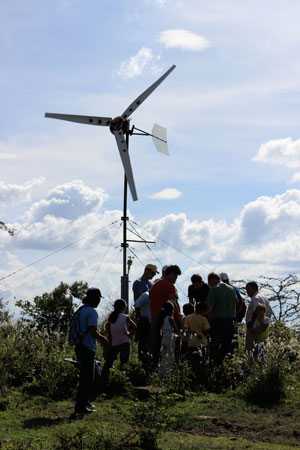Nestled within the vast world of University of Minnesota student groups is a true gem: Innovative Engineers (IE). They’re busy working with people across the world to improve their communities and the quality of life. Current Vice President, Steven Maurer, an undergraduate in Mechanical Engineering, shares a few of their most inspiring recent stories in the interview below.
Lauren Werner-Foley: What does Innovative Engineers do and strive to achieve?
Steven Maurer: Innovative Engineers is centered on the ideals outlined in our mission statement which reads: “To craft engineers from students by developing clean energy solutions, connecting them with communities, and building lasting relationships.” Our ultimate goal is to build relationships with communities throughout the world and empower their citizens. We do this by collaborating on clean energy solutions in the areas of wind, water, and—most recently—solar power solutions. It is very important to us to work in collaboration with others so we can make lasting relationships. We hope the relationships we build and the knowledge we share while working on our projects provide the basis for a truly sustainable community. We also have a focus on bringing science and engineering interest and education to local students. We participate in outreach events such as the Math and Science Family Fun Fair hosted by the University of Minnesota. In addition we help with a project at the White Earth Indian Reservation where we teach science curriculum. This outreach program is a collaborative effort with two other UMN student organizations, the National Society of Black Engineers and the American Indian Science and Engineering Society.
Lauren: Tell me about the work IE does with clean energy or energy efficiency.
Steven: On the project level IE is entirely focused on clean energy solutions. We currently have 5 projects.
- First, the 1kW wind turbine. This project is developing a wind turbine that can be made with the supplies found by the locals of the communities in which the turbine will be placed.
- The Micro-Hydro 1kW turbine is designed and constructed in collaboration with our partners in Nicaragua.
- IE is trying to improve the design of wind and hydro turbine blades to make them more effective.
- The hydrostatic turbine is a research project on the efficiency of using hydraulics to transmit power in a wind turbine.
- Finally, the Solar Autoclave, which is a fairly new project looking to use the sun’s power to sterilize medical equipment.
 Lauren: Are there any projects you’ve made a lot of progress on lately?
Lauren: Are there any projects you’ve made a lot of progress on lately?
Steven: Recently, we’ve been working a lot with the Micro-Hydro turbine. It is a 1 kilowatt turbine designed to be made with minimal machinery in order to enable assembly in locations where engineering facilities are rare and materials may be hard to access. Although the final design had a more rugged appearance then our original, more complex plan, the turbine is effective and easy to assemble. After working on the turbine in Nicaragua, we decided that the people there could do a better job designing and manufacturing blades suitable to their turbines. The completion of the project has been put into the hands of our Nicaraguan connections. They are currently designing blades out of materials readily available to them such as multiple types of wood and bamboo and testing them to find the best fit.
Lauren: Have you had any recent achievements on your many projects?
Steven: We’re very proud of our past achievements! Most notably is the completion of a 1 kilowatt turbine in a small village near Jinotega, Nicaragua. With the completion of this turbine we were listed in the 2012 Sustainia100. This list recognizes the top 100 solutions for sustainability in the world each year.
The wind-generated electricity charges car batteries which the locals can then use to power household items such as lights or motors. These things may seem simple to us but in an area with no electricity of any kind, the wind turbine is truly revolutionary. This past fall we returned to the site to help with maintenance. While there one of the local children presented us with a miniature replica of the turbine that was amazingly accurate! This hit home with the goals of IE. The child found an interest in science and engineering that he would likely never have been exposed to otherwise. It was nothing short of inspiring.
Furthermore, starting this year we have organized a “summit” at which the UMN Innovative Engineers, National Engineering University in Nicaragua, our partners at Villanova University and others will meet, work on projects, discuss progress, and collaborate on new ideas. The summit will take place every August.
Lauren: *_Can you suggest any resources for people who want to learn more?*_
Steven: Sure!
- American Indian Science and Engineering Society
- National Society of Black Engineers
- 2012 Sustainia list – our project is listed on page 77


